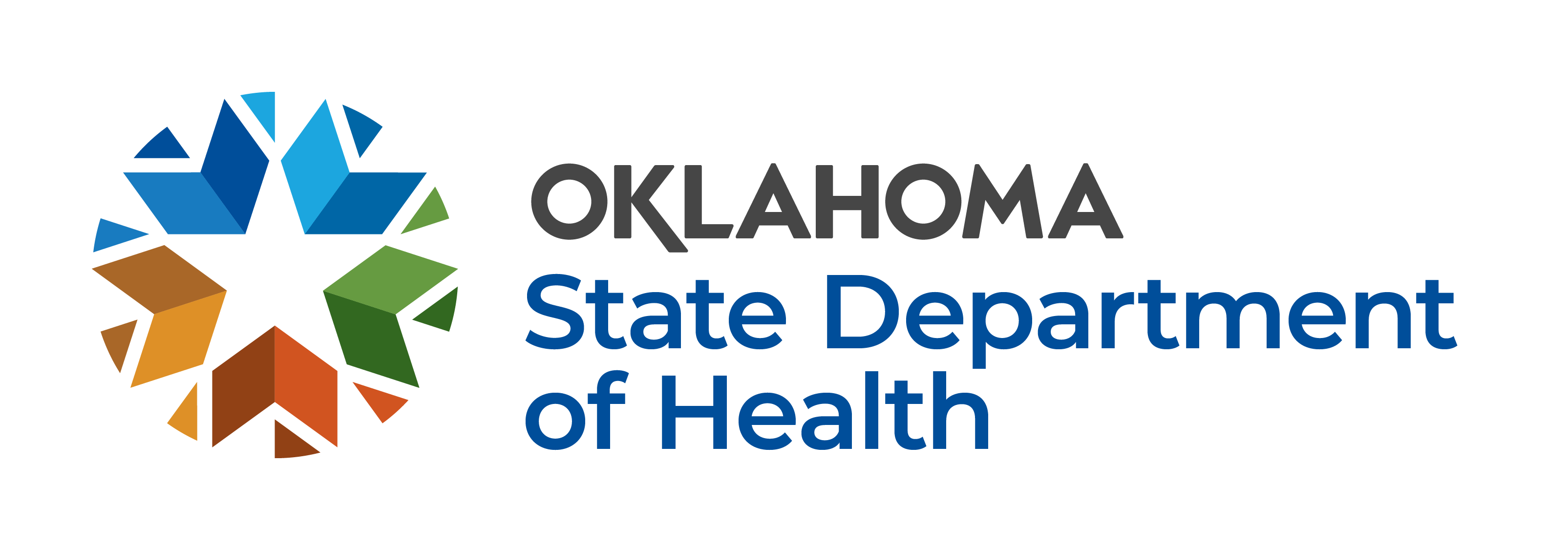- Bacillus anthracis
- Brucella spp.
- Carbapenem-resistant Enterobacteriaceae
- Carbapenem-resistant Pseudomonas aeruginosa
- Carbapenem-resistant Acinetobacter spp.
- E. coli O157, O157:H7, or a Shiga toxin producing E. coli
- Francisella tularensis
- H. influenzae (sterile site isolates only)
- Listeria spp. (sterile site isolates only)
- Mycobacterium tuberculosis
- N. meningitidis (sterile site isolates only)
- Plasmodium spp.
- Salmonella spp.
- Vibrionaceae family (Vibrio spp., Grimontia spp., Photobacterium spp., and other genera in the family)
- Yersinia spp.
What to Report
Oklahoma Administrative Code (OAC) Reportable Disease Rules – OAC 310:515 specifies which diseases and conditions are reportable and the timeframe and methods for reporting.
Oklahoma Administrative Code (OAC) Novel Coronavirus Regulations – OAC 310:517 specifies reporting regulations specific to novel coronaviruses.
The Oklahoma Disease Reporting Manual further defines the specifics for clinical and laboratory reporting requirements for diseases and conditions. In addition to reporting requirements, the manual contains guidance in determining if an event should be reported, and specifies which specimens and isolates are required to be forwarded to the OSDH Public Health Laboratory.
Printable posters for reportable diseases & conditions
When to Report
Click the down arrow on the options below to view a list of diseases that fall under the required reporting timelines. Report diseases by PHIDDO or by telephone at 405-426-8710.
- Anthrax
- Bioterrorism-suspected disease
- Botulism
- Diptheria
- Free-living amebae infections causing primary amebic meningoencephalitis
- Hepatitis B during pregnancy (HBsAg+)
- Measles (Rubeola)
- Meningococcal invasive disease
- Novel coronavirus
- Novel influenza A
- Outbreaks of apparent infectious disease
- Orthopox viruses (i.e., Smallpox, Monkeypox)
- Plague
- Poliomyelitis
- Rabies
- Typhoid fever
- Viral hemorrhagic fever
- Acid Fast Bacillus (AFB) positive smear
- Only if no additional testing is performed or subsequent testing is indicative of Mycobacterium tuberculosis Complex.
- AIDS (Acquired Immunodeficiency Syndrome)
- Anaplasmosis
- Brucellosis
- California serogroup virus infection
- Campylobacteriosis
- Chikungunya virus infection
- Congenital rubella syndrome
- Cryptosporidiosis
- Cyclosporiasis
- Dengue fever
- Eastern equine encephalitis virus infection
- E. coli O157, O157:H7, or a Shiga toxin producing E. coli (STEC)
- Ehrlichiosis
- Haemophilus influenzae invasive disease
- Hantavirus infection, without pulmonary syndrome
- Hantavirus pulmonary syndrome
- Hemolytic uremic syndrome, postdiarrheal
- Hepatitis A (Anti-HAV-IgM+)
- Hepatitis B (HBsAg+, anti-HBc IgM+, HBeAg+, and/or HBV DNA+) 1
- For infants 18 months and younger, all hepatitis B related tests ordered, regardless or test result, must be reported.
- Hepatitis C virus (having jaundice or ALT ≥ 200 with laboratory confirmation) 1
- If hepatitis C EIA is confirmed by NAT for HCV RNA, or s/co ratio or index is predictive of a true positive, then report the results of the entire hepatitis panel. Positive HCV RNA are reportable by both laboratories and providers. Negative test results for HCV RNA tests are reportable by laboratories only.
- For infants 18 months and younger, all hepatitis C related tests ordered, regardless or test result, must be reported.
- Human Immunodeficiency Virus (HIV) infection
- All tests indicative of HIV infection are reportable by laboratories and providers. If any HIV test is positive, then all HIV test results on the panel must be reported by laboratories. For infants 18 months and younger, all HIV tests ordered, regardless of test result must be reported by laboratories. All HIV nucleotide sequences and negative HIV test results are only reportable by laboratories.
- Influenza-associated hospitalization or death
- Legionellosis
- Leptospirosis
- Listeriosis
- Lyme disease
- Malaria
- Mumps
- Pertussis
- Powassan virus infection
- Psittacosis
- Q Fever
- Rubella
- Salmonellosis
- SARS-CoV-2 (COVID-19)
- Shigellosis
- Spotted Fever Rickettsiosis (Rickettsia spp.) hospitalization or death
- St. Louis encephalitis virus infection
- Streptococcal disease, invasive, Group A (GAS)
- Streptococcus pneumoniae invasive disease in children 5 years or younger.
- Syphilis
- Nontreponemal and treponemal tests are reportable. If any syphilis test is positive, then all syphilis test results on the panel must be reported. For infants 18 months and younger, all syphilis tests ordered, regardless of test result, must be reported.
- Tetanus
- Trichinellosis
- Tuberculosis
- Tularemia
- Unusual disease or syndrome
- Vibriosis including cholera
- West Nile virus infection
- Western Equine encephalitis virus infection
- Yellow fever
- Zika virus infection
1 with entire Hepatitis panel results
- CD4 Cell Count with cell count % (by laboratories only)
- Chlamydial infections (C. trachomatis)
- Creutzfeldt-Jakob disease
- Gonorrhea
- HIV viral load (by laboratories only)
- LGV (Lymphogranuloma venereum is reportable as Chlamydia and designated as LGV).
Isolates Reporting
Occupational and Environmental Disease Reporting
The following laboratory results for adults and children must be reported to the OSDH Oklahoma Childhood Lead Poisoning Prevention Program.
Laboratories and health care providers doing in-office testing must report blood lead level results equal to or greater than 3.5 µg/dL within one (1) week and results less than 3.5 µg/dL within one (1) month.
Laboratories and all health care providers must report blood lead level results of 20 µg/dL or greater within twenty-four (24) hours.
Contact Information
Mailing Address:
Oklahoma State Department of Health
Infectious Disease Prevention and Response
123 Robert S. Kerr Ave, Ste. 1702
Oklahoma City, OK 73102-6406
Physical Address:
Oklahoma State Department of Health
123 Robert S. Kerr Ave
Oklahoma City, OK
Phone: (405) 426-8710
Fax: (405) 900-7591
Email: IDPRService@health.ok.gov


